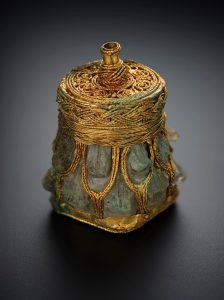The discovery of the Galloway Hoard in 2014 was a landmark event in the field of archaeology, unveiling a remarkable collection of Viking-era treasures that continues to amaze scholars and enthusiasts worldwide. Among the artifacts recovered, a carved rock crystal jar has drawn particular attention. Recently cleaned and meticulously conserved by experts at the National Museums Scotland (NMS), this jar has revealed new secrets about its origins and craftsmanship. Initially believed to be of Carolingian origin, the jar has now been identified as a Roman crystal artifact from the late 8th or early 9th century, encased in elaborate layers of gold thread. This ongoing conservation project is providing fresh insights into the jar’s history and its journey through time, deepening our understanding of its role within the richest Viking hoard ever discovered in Britain or Ireland.

The Galloway Hoard was unearthed in September 2014 by a metal detectorist in a field near Castle Douglas in Dumfries and Galloway, Scotland. This incredible assemblage of high-status Viking objects represents the most significant hoard of its kind ever found in Britain or Ireland. In 2017, the National Museums Scotland acquired the hoard for an ex gratia payment of £1.98 million ($2,550,000), paving the way for an extensive and detailed analysis of the artifacts it contained.
The conservation and cleaning process has gradually revealed an astonishing array of rare items. These include a silver pectoral cross decorated with niello enamel, a unique gold bird-shaped pin, and a silver-gilt pot, originally thought to have been produced within the Carolingian Empire. The pot, one of only three known from Britain, was found intact with its original lid and wrapped in woven textiles. To preserve these delicate textiles and examine the pot’s contents without damaging them, conservators employed advanced CT scanning technology. This process revealed an extraordinary assortment of treasures inside, including a 9th-century Anglo-Saxon brooch, an Irish penannular brooch, a gold reliquary pendant, and a hinged silver strap.
Perhaps one of the most fascinating aspects of the conservation efforts has been uncovering the Persian connection of the silver-gilt pot. Through 3D imaging created from X-ray scans, researchers discovered that the pot’s iconography—featuring leopards, tigers, and Zoroastrian symbols—was not Carolingian, as previously assumed, but Sasanian. This finding indicated that the vessel originated from Persia rather than continental Europe. Radiocarbon dating of the textiles wrapped around the pot further confirmed that it was made between 680 and 780 A.D., meaning it was already 100 to 200 years old when it was buried as part of the hoard.
Amid the treasures contained in the silver-gilt pot, one object stands out: the carved rock crystal jar. When first uncovered, the jar was found within a silk-lined leather pouch. Detailed 3D X-ray imaging revealed a Latin inscription on the jar’s base, reading, “Bishop Hyguald had me made.” This inscription, along with the jar’s intricate design, suggests that it began its life as the capital of a Corinthian column made of rock crystal during the late Roman Empire. Over centuries, this crystal capital was transformed into a jar and wrapped in delicate gold thread, creating the stunning artifact we admire today.
The rock crystal jar offers a unique glimpse into the past, not only because of its exceptional craftsmanship but also due to the potential insights it holds about Viking-era culture and practices. Experts believe the jar may still contain trace elements of the potion it once held. If so, modern scientific techniques could analyze these remnants to identify the chemicals used. Dr. Martin Goldberg, the principal curator of early medieval and Viking collections at NMS, has speculated that the jar might have held a rare and exotic liquid, such as a perfume from the Orient or an anointing oil used in royal or ecclesiastical ceremonies. Such a discovery would shed light on the cultural and religious practices of the time, offering a rare window into the Viking world and its interactions with other cultures.
The Galloway Hoard continues to captivate audiences with its extraordinary array of artifacts, each of which tells a unique story about the past. The carved rock crystal jar, now identified as a Roman creation wrapped in gold thread, stands as a testament to the remarkable craftsmanship and rich history of the Viking era. This artifact not only underscores the Vikings’ ability to acquire and repurpose objects from distant lands but also highlights the cultural and trade connections that flourished during this period.
As the conservation project at the National Museums Scotland progresses, even more revelations about the Galloway Hoard are expected. Each artifact contributes a new layer to our understanding of Viking society, their values, and their far-reaching networks of trade and influence. The Galloway Hoard reminds us of the enduring legacy of the Vikings and the stories that can be uncovered through careful study of the objects they left behind. The rock crystal jar, with its intricate gold wrapping and storied past, is just one example of how these artifacts continue to bridge the gap between past and present, bringing history to life in ways that inspire awe and curiosity.





